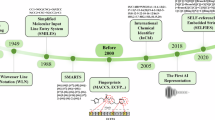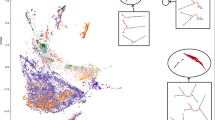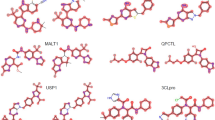Abstract
Aim:
The search for molecules whose bioactivities are similar to those of given compounds or to optimize the initial lead compounds from high throughput screening has attracted increasing interest in recent years. Our goal is to provide a publically searchable database of scaffolds out from a large collection of existing chemical molecules.
Results:
Although a number of in silico methods have emerged to facilitate this process, which has become known as ”scaffold hopping” or “molecular hopping”, there is an urgent need for a database system to provide such valuable data in the drug design field. Here we have systematically analyzed a collection of commercially available small molecule databases and a bioactive compound database to identify unique scaffolds and we have built apublically searchable database. The analysis of approximately 4 800 000 of these compounds identified 241 824 unique scaffolds, which are stored in a relational database (http://202.127.30.184:8080/db.html). Each entry in the database is associated with a molecular occurrence and includes its distribution of molecular properties, such as molecular weight, logP, hydrogen bond acceptor number, hydrogen bond donor number, rotatable bond number and ring number. More importantly, for scaffolds derived from the bioactive compounds database, it also contains the original compounds and their target information.
Conclusion:
This Web-based database system could help researchers in the fields of medicinal and organic chemistry to design novel molecules with properties similar to the original compounds, but built on novel scaffolds.
Similar content being viewed by others
Log in or create a free account to read this content
Gain free access to this article, as well as selected content from this journal and more on nature.com
or
References
Brown N, Jacoby E . On scaffolds hopping in medicinal chemistry. Mini Rev Med Chem 2006; 6: 1217–29.
Zhao H . Scaffold selection and scaffold hopping in lead generation: a medicinal chemistry perspective. Drug Discov Today 2007; 12: 149–55.
Bajorath J . Integration of virtual and high-throughput screening. Nat Rev Drug Disc 2002; 1: 882–94.
Barnum D, Greene J, Smellie A, Sprague P . Identification of common functional configurations among molecules. J Chem Inf Comput Sci 1996; 36, 563–71.
Eckert H, Bajorath J . Molecular similarity analysis in virtual screening: foundations, limitations and novel approaches. Drug Discov Today 2007; 12: 225–33.
Klebe G . Virtual ligand screening: strategies, perspectives and limitations. Drug Discov Today 2006; 11: 580–94.
Khedkar SA, Malde AK, Coutinho EC, Srivastava S . Pharmacophore modeling in drug discovery and development: an overview. Med Chem 2007; 3: 187–97.
Schneider G, Fechner U . Computer-based de novo design of druglike molecules. Nat Rev Drug Discov 2005; 4: 649–63.
Zhao H, Xin Z, Liu G, Schaefer VG, Falls HD, Kaszubska W, et al. Discovery of tetralin carboxamide growth hormone secretagogue receptor antagonists via scaffold manipulation. J Med Chem 2004; 47: 6655–7.
Bemis GW, Murcko MA . The properties of known drugs. 1. Molecular frameworks. J Med Chem 1996; 39: 2887–93.
Xu J . A new approach to finding natural chemical structure classes. J Med Chem 2002; 45: 5311–20.
Lewell XQ, Judd DB, Watson SP, Hann MM . RECAP--retrosynthetic combinatorial analysis procedure: a powerful new technique for identifying privileged molecular fragments with useful applications in combinatorial chemistry. J Chem Inf Comput Sci 1998; 38: 511–22.
Irwin JJ, Shoichet BK . ZINC–a free database of commercially available compounds for virtual screening. J Chem Inf Model 2005; 45: 177–82.
PubChem database. Avaiable from http://pubchem.ncbi.nlm.nih.gov/
MDL Drug Data Report database (MDDR). Avaible from http://www.mdli.com/
Wishart DS, Knox C, Guo AC, Shrivastava S, Hassanali M, Stothard P, et al. Woolsey DrugBank: a knowledgebase for drugs, drug actions and drug targets. J Nucleic Acids Res 2006; 34: D668–72
Guha R, Howard MT, Hutchison GR, Murray-Rust P, Rzepa H, Steinbeck C, et al. The Blue Obelisk– interoperability in chemical informatics. J Chem Inf Model 2006; 46: 991–8. Avaiable from http://openbabel.sourceforge.net/
Wilkens SJ, Janes J, Su AI . HierS: hierarchical scaffold clustering using topological chemical graphs. J Med Chem 2005; 48: 3182–93.
Figueras J . Ring perception using Breadth-first search. J Chem Inf Comput Sci 1996; 36: 986–91.
ChemAxon. Avaiable from http://www.chemaxon.com/jchem/
Steinbeck C, Han Y, Kuhn S, Horlacher O, Luttmann E, Willighagen E . The chemistry development kit (CDK): an open-source Java library for chemo- and bioinformatics. J Chem Inf Comput Sci 2003; 43: 493–500.
MySQL database system. Avaible from http://www.mysql.com/
Babaoglu K, Shoichet BK . Deconstructing fragment-based inhibitor discovery. Nat Chem Biol 2006; 2: 720–3.
Acknowledgements
This project was supported by the National Natural Science Foundation of China (Grant No 30600784) and the Knowledge Innovation Program of the Chinese Academy of Sciences, SIMM0709QN-18 (Grant No O7G602R012)
We thank Dr David L BURK and Dr Prof Albert M BERGHUIS (McGill University, Canada) for reading the manuscript and for helpful discussions. We thank ChemAxon Inc for providing the JAVA software packages JChem and Marvin.
Author information
Authors and Affiliations
Corresponding authors
Rights and permissions
About this article
Cite this article
Yan, Bb., Xue, Mz., Xiong, B. et al. ScafBank: a public comprehensive Scaffold database to support molecular hopping. Acta Pharmacol Sin 30, 251–258 (2009). https://doi.org/10.1038/aps.2008.22
Received:
Accepted:
Published:
Issue date:
DOI: https://doi.org/10.1038/aps.2008.22
Keywords
This article is cited by
-
Consensus Diversity Plots: a global diversity analysis of chemical libraries
Journal of Cheminformatics (2016)
-
Peptide Scaffolds: Flexible Molecular Structures With Diverse Therapeutic Potentials
International Journal of Peptide Research and Therapeutics (2012)
-
Open Babel: An open chemical toolbox
Journal of Cheminformatics (2011)



